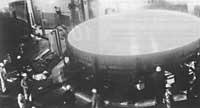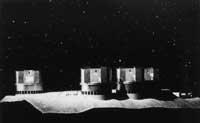Astronomers in search of paradises
1992/01/01 Brunier, Serge Iturria: Elhuyar aldizkaria
To achieve maximum efficiency, in the future telescopes will need a sky with the purest. In the northern hemisphere, astronomers have found nothing better than Mauna Kea, the highest volcano in Hawaii. Under the equator, VLT (Very Large Telescope) is installed on the Cerro Paranal in Chile of the Atacama Desert: European telescope called very large telescope.
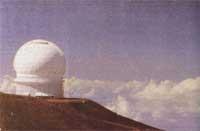
Almost nine years ago Francisco Gómez Cerda and his two children settled in seasons in Cerro Paranal. This 2,665 m mountain is located in the heart of the Atacama Desert in Chile. What was their role? Analyze the weather characteristics of the country for the European Southern Observatory (ESO), compare them with those existing in other arid places of the world and finally help astronomers choose the place where the huge astronomical machine will be installed in five years, the so-called VLT that we have mentioned above. The Gómez Cerda family is very proud and European astronomers have announced great news: that they have chosen their mountain to put the telescope...
Since 1983, Chilean meteorologists have recorded all the parameters, that is, the cleaning of the sky, the number of clear nights, the humidity of the air, the atmospheric stability, etc. all this influences the quality of astronomical observation.
In the history of astronomy such a campaign has never been initiated: A dozen mountains of Chile and another on the island of Reunion have been constantly examined to find the perfect sky. Astronomers soon realize that Chile had the best sites. Three large observatories have already been installed there, the Americans Cerro Tololo and Las Campanas, and especially the great observatory of ESO, in La Sillan. It is one of the most important astronomical centers in the world today.
VLT will therefore be installed in Chile. It was a question of ESO's "politicians" to make a difficult decision: In La Silla, on the banks of the Atacama Desert, seeing that there is already a huge infrastructure (fifteen telescopes inside the dome, an airport, a road of 30 km, a real "country of science" for more than one hundred people, ultramodern workshops, computer equipment, etc. ), VLT installation on site or location of better location and replenishment.
Decision taken. Cerro Paranal, 600 km north of La Silla, is the best astronomical place on the planet: at three hundred and thirty nights of the year the sky is clear. Knowing that with the VLT every second of observation will cost around 10 pounds, it is understood why Europeans have tried so much to look for the right place. Passing the smallest fog in the sky can cause a scientific "loss" of 1,000, 10,000 or 100,000 pounds! ...
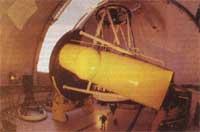
But the mists, the clouds, the rain… they hardly know what they are in the Atacama Desert, one of the most arid places on the planet. The Gómez Cerda family of Cerro Paranal said: "In 1983 it rained several times and in 1988 we snowed." Paradoxically, 15 km from the top, meteorologists can contemplate the Pacific coast almost permanently covered with fog. But these mists do not exceed 1,000 or 1,500 m. The bad weather seasons correspond to the "Bolivian winter" and the storm then proceeds from the Andes, to the east.
Until about thirty years ago, astronomers did not care about local weather quality during the installation of telescopes: the largest telescopes in the world, until the 1970s, have been installed near cities. Nice and Meudo can therefore be proud of the great observatories built at the end of the last century. Today its beautiful telescopes are hardly useful.
The situation of the first giant telescopes is even more serious. The one on California's Mount Wilson revolutionized early century astrophysics, now closed. This tool has not been able to withstand the advances in electricity and night lighting. Very sensitive to this "light pollution", he has stopped investigating the sky. Damage: Its medium 2 m t"mirror was one of the twenty largest telescopes in the world.
Another giant, more famous, staggers: Famous five-metre telescope on Mount Palomar. In the late 1920s, designers sought a real place: At 2,000 m, in Southern California, the Palomar seemed an ideal place. Atmospheric turbulence halves its resources to the telescope and, above all, the city of Los Angeles, two hundred kilometers, illuminates its neon sky, This tool has been surpassed by others better located, although theoretically not so powerful.
Today, due largely to the weather satellites and the good simulation of atmospheric circulation, astronomers know perfectly what are the most suitable places to install a large modern observatory. Not so much: The Atacama Desert in Chile is undoubtedly the best place, but the Canary Islands and Hawaii, with their high volcanoes, have almost three hundred clear nights a year. Altitudes (2,200 to 4,200 m) protect them from ocean mists.
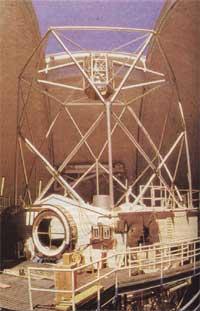
Finally, in the Rocky Mountains, in the Pamir of the Soviet Union and in the Chinese Himalayas, some deserts called continental, undoubtedly, have beautiful summits at 5,000 m from 3,000. An unknown place remains: Antarctica. This large virgin continent, from 3,000 to 5,000 m high, has a completely dry and pure atmosphere. But can you think of installing astronomers, giant telescopes and computers in the -55º freezer? At present very special works such as permanent observation of the Sun are carried out for several weeks.
The common characteristic of all the mountains that astronomers want is, logically, to be far from the pollution and illumination of civilization, but also from other mountains. The isolated summits have a totally stable and pure atmosphere. The dream of all astronomers in the northern hemisphere is to install their telescopes on the Mauna Kea volcano in Hawaii. At 4,200 m it is protected from dust and lights of the low atmosphere and up to 2,000 m the slopes of this volcano are covered by a set of mists. Being almost three hundred clear nights a year is not a bad astronomical place.
But above all, Mauna Ke is characterized by the stability of the air: the atmospheric turbulence that mixes the images of the telescope is very low there. Another advantage of Mauna Ke is that its dry air allows astronomers to study infrared rays. These rays are absorbed by water vapor, so modern places must be completely dry. Mauna Kea currently has the largest number of telescopes in the world: the ten-meter Californian telescope, which inhabits them in the world, the 3.6 m Franco-Canadian telescope (currently emits the most accurate images of galaxies and quasars), the largest infrared telescope in the world, the pios of radiiteles...
But Cerro Paranal undoubtedly surpasses all the already exploited places. Better than Mauna Kea, taking into account clear nights and atmospheric stability, and at least equally good in terms of air dryness. In that place, the VLT should take pictures like any space telescope or better! With four 8.20 m diameter mirrors, VLT, more than fifty times brighter than Hubble. It is equipped with adaptive optics, that is, an optics capable of deforming according to atmospheric turbulence.
This large European telescope will have no competition in the XXI. at the beginning of the century. The tool will cost about 1.5 billion pounds, ten times less than Hubble! But it will be faster, brighter and more accurate... and even if a space mission of the end of 1993 returns the view to the space telescope. The discovery of places like Cerro Paranal and the advances in optics have led astronomers to return to the ground: they do not intend to install large telescopes in orbit.
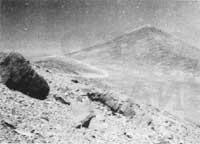
The work of Europeans is to build their giant machine. One of the problems ESO faces is working hard on it. First of all, Cerro Paranal, of course, has neither water nor electricity. Take the Antofagasta, 100 kilometers away. Immediately the top must be matched in order to have VLT. Once leveled, Cerro Paranal will have a platform of approximately one hectare to house the first 8.20 m telescope since 1995.
In the year 2000, the complete tool, forming a trapezium of 100 m of base, will begin to observe the quasars of the farthest places. Therefore, there will be no room to install up there another telescope! But the other possibilities of building giant telescopes on this Chilean summit are not ruled out: Near Cerro Paranal, other virgin mountains also exhibit their peaks at the foot of the great mountain range. Atacama can become the "desert of astronomers."
Giant telescopes
It all began in 1949 with the launch by the Americans of the first great optical apparatus, the huge telescope of Mount Palomar. It is equipped with mirrors of five meters in diameter, weighs 530 tons and for decades has dominated world astronomy... The USSR wanted to surpass the Californians in 1976 by installing an even larger tool in Celentxuk, Kaukaso. With a length of 25 m, moving 600 tons and a mirror of 6 m in diameter, "BTA-B6" has never fulfilled its promises: At 1,900 m its location is not very good and its electronic cameras are not very practical.
Desperate, astronomers tried to find better places than to increase the size of mirrors and improve their optical and electronic characteristics. The result: in the last ten years, the French-Canadian CFH telescope, 3.60 m in diameter, installed at 4,200 m in the Mauna Ke in Hawaii, has records of magnitude (weakness of visual stars) and spatial resolution (accuracy of accessible details). Expressed in figures: Magnitude 27 (CFH can see 250 million times weaker than the weaker stars that can be seen at first sight) Resolution 0.3" (any 500 m object of the Moon).
The Chilean Sillan, the 3.5 m European New Technology Telescope, has begun to deliver the same results. The advance of opto-electronic electronics has allowed astronomers to face the challenge of the giant: this year Californians will install a 10-meter diameter telescope at the Mauna Kean! The tool does not weigh more than 300 m and consists of "intelligent" fractional mirrors, formed by 36 glass hexagons. This telescope is a pioneer in ultra-light giant telescopes and generations capable of analyzing visible and infrared light.
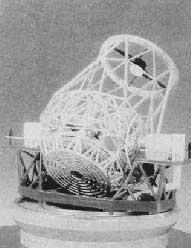
In project: Installable in Hawaii Keck II and the Japanese JNLT, of 7.50 m, American Magellan of 8 m of Atacama, pair of Columbus telescopes of 8 m of diameter for Arizona and, above all, European VLT for the year 2000: Battery of four 8.20 m telescopes capable of synthesizing a 16 m diameter telescope. Being the largest of all telescopes in the future, the VLT will have no competition for decades to come.

Gai honi buruzko eduki gehiago
Elhuyarrek garatutako teknologia




